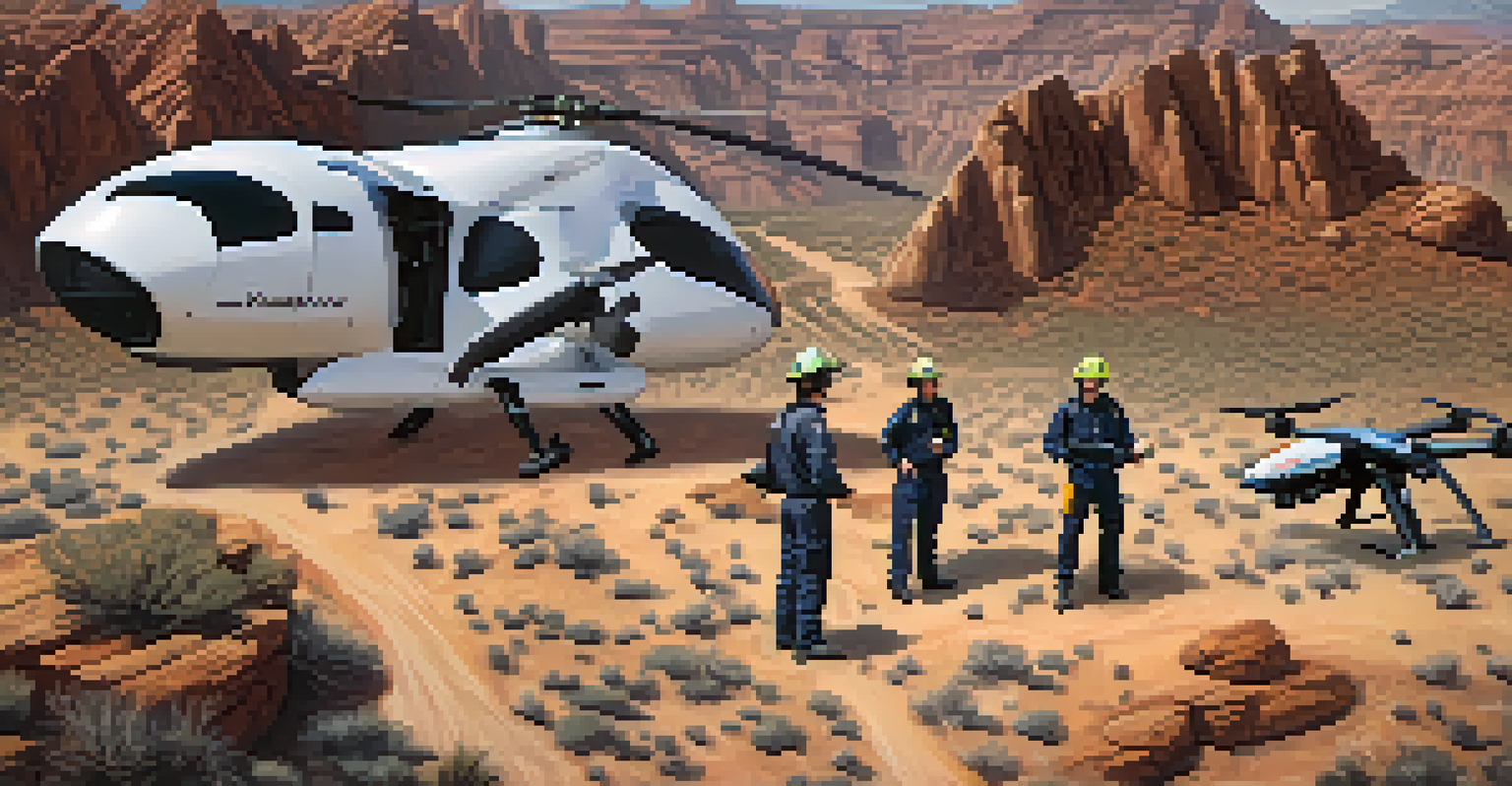The Role of Technology in Arizona's Disaster Management Plans

Overview of Arizona's Disaster Management Landscape
Arizona faces a unique set of challenges when it comes to disaster management, including wildfires, floods, and extreme heat. The state's landscape and climate necessitate robust planning and preparedness strategies. Understanding the local geography and potential hazards is crucial for effective disaster response.
The greatest danger in times of turbulence is not the turbulence; it is to act with yesterday's logic.
In recent years, the importance of technology in disaster management has become increasingly clear. From early warning systems to data analytics, technology plays a pivotal role in enhancing response efforts. By integrating these tools, Arizona aims to minimize the impact of disasters on its communities.
Moreover, collaboration between state agencies, local governments, and technology providers is essential. This partnership helps create comprehensive disaster management plans that leverage the latest innovations. Ultimately, the goal is to ensure that Arizona is well-prepared for whatever challenges may arise.
The Role of Early Warning Systems
Early warning systems are crucial in mitigating disaster risks. These systems provide timely alerts about impending threats, allowing communities to prepare and respond effectively. For instance, Arizona utilizes advanced weather forecasting technologies to predict severe storms and flash floods.

By harnessing real-time data from satellites and radar, these systems can deliver accurate information to emergency responders and the public. This proactive approach significantly reduces the likelihood of casualties and damage during disasters. For example, timely warnings during monsoon season can help residents evacuate or take necessary precautions.
Technology Enhances Disaster Response
Integrating advanced technologies like early warning systems and drones significantly improves Arizona's ability to manage and respond to disasters.
Additionally, public awareness campaigns about these early warning systems play a vital role in their effectiveness. Educating residents on how to respond to alerts ensures that they are better prepared during an emergency. Engaging communities in disaster preparedness fosters resilience and can save lives.
Using Drones for Disaster Response
Drones are revolutionizing disaster management by providing real-time aerial surveillance. In Arizona, drones are deployed to assess damage, locate victims, and monitor ongoing situations. This technology offers a bird's-eye view that is invaluable during chaotic events.
Technology is best when it brings people together.
For example, during wildfires, drones can quickly survey large areas to identify hotspots and assess the spread of flames. This information allows firefighters to strategize their response more effectively. Additionally, drones can deliver supplies or aid to hard-to-reach areas, enhancing the overall response efforts.
The use of drones also facilitates data collection for future planning. By analyzing aerial footage and data from past disasters, officials can refine their strategies and improve preparedness. As drone technology continues to evolve, its integration into disaster management will likely expand.
Data Analytics and Predictive Modeling
Data analytics plays a vital role in anticipating and managing disasters in Arizona. By analyzing historical data, officials can identify patterns and potential risks. Predictive modeling allows for more informed decision-making when it comes to resource allocation and emergency response planning.
For instance, data from previous wildfire seasons can help predict areas at higher risk in future years. This insight enables targeted interventions, such as controlled burns or community education efforts. By leveraging data, Arizona can focus its resources where they are needed most.
Community Engagement is Essential
Involving local residents in disaster preparedness through technology fosters resilience and empowers individuals to take charge of their safety.
Furthermore, real-time data collection during a disaster can enhance situational awareness. Emergency responders can track the effectiveness of their strategies and make adjustments as needed. This continuous feedback loop is essential for improving disaster management outcomes.
Communication Technologies in Crisis Situations
Effective communication is critical during disaster response efforts. In Arizona, technology facilitates seamless communication between agencies, emergency responders, and the public. Tools such as mobile apps and social media platforms help disseminate vital information quickly.
For example, during a natural disaster, social media can serve as a real-time information hub. Officials can share updates, safety tips, and evacuation routes, ensuring that residents are informed. This immediate access to information can make a significant difference in people's safety and decision-making.
Moreover, communication technologies also enhance coordination among first responders. By sharing real-time updates and data, agencies can work collaboratively to address challenges as they arise. This interconnectedness is essential for a swift and effective response during emergencies.
Community Engagement Through Technology
Engaging the community is a cornerstone of effective disaster management. Technology offers various platforms to involve residents in preparedness efforts. Online training programs, webinars, and social media campaigns can educate the public about disaster risks and response strategies.
For instance, Arizona has implemented community programs that encourage residents to create emergency plans. By utilizing apps and online resources, families can develop personalized plans tailored to their needs. This proactive approach empowers individuals to take charge of their safety during disasters.
Challenges in Tech Integration Persist
Despite the benefits, obstacles such as funding, data privacy, and the need for training hinder the effective integration of technology in disaster management.
Additionally, technology facilitates feedback from the community post-disaster. Surveys and online forums allow residents to share their experiences and suggest improvements. This collaborative approach fosters a culture of resilience and continuous learning, ultimately strengthening Arizona's disaster management efforts.
Challenges of Integrating Technology
While technology offers numerous benefits, integrating it into disaster management is not without challenges. Funding is often a significant barrier, as state and local agencies may struggle to secure the necessary resources. This limitation can hinder the adoption of advanced technologies that could improve response efforts.
Additionally, there are concerns about data privacy and security. As more technologies are employed, ensuring that sensitive information remains protected becomes paramount. Striking a balance between utilizing data for better responses and safeguarding individuals' privacy is essential.

Finally, there is the need for training and education for emergency responders. As new technologies emerge, continuous training programs must be established to ensure that personnel are equipped to utilize these tools effectively. Addressing these challenges is crucial for maximizing the potential of technology in disaster management.
The Future of Technology in Disaster Management
Looking ahead, the role of technology in Arizona's disaster management is poised to grow even more significant. Innovations such as artificial intelligence and machine learning can enhance predictive analytics, making disaster response even more proactive. These advancements could lead to faster and more accurate assessments of risks.
Moreover, as technology continues to evolve, community engagement tools will likely become more accessible. Virtual reality training simulations and mobile applications can further empower residents to prepare for disasters effectively. This shift towards technology-driven engagement will foster a more resilient community.
Ultimately, embracing technology offers Arizona the opportunity to improve its disaster management strategies. By leveraging these tools, the state can better protect its residents and minimize the impacts of disasters. The future looks promising as Arizona continues to innovate and adapt in the face of challenges.